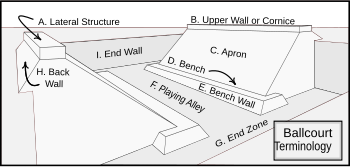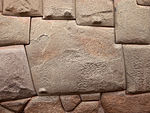
Qʼuqʼumatz was a god of wind and rain of the Postclassic Kʼicheʼ Maya. It was the Feathered Serpent that according to the Popol Vuh created the world and humanity, together with the god Tepeu. It carried the sun across the sky and down into the underworld and acted as a mediator between the various powers in the Maya cosmos. It is considered to be the equivalent of the Aztec god Quetzalcoatl and of Kukulkan, of the Yucatec Maya.
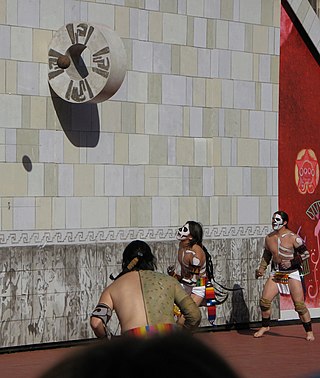
The Mesoamerican ballgame was a sport with ritual associations played since at least 1650 BC by the pre-Columbian people of Ancient Mesoamerica. The sport had different versions in different places during the millennia, and a modernized version of the game, ulama, is still played by the indigenous populations in some places.

Yaxchilan is an ancient Maya city located on the bank of the Usumacinta River in the state of Chiapas, Mexico. In the Late Classic Period Yaxchilan was one of the most powerful Maya states along the course of the Usumacinta River, with Piedras Negras as its major rival. Architectural styles in subordinate sites in the Usumacinta region demonstrate clear differences that mark a clear boundary between the two kingdoms.

Zaculeu or Saqulew is a pre-Columbian Maya archaeological site in the highlands of western Guatemala, about 3.7 kilometres (2.3 mi) outside the modern city of Huehuetenango. Occupation at the site dates to the Early Classic period (AD 250–600) of Mesoamerican history. Zaculeu was the capital of the Postclassic Mam kingdom, and was conquered by the Kʼicheʼ Kingdom of Qʼumarkaj. It displays a mixture of Mam and Kʼicheʼ style architecture.

Ulama is a ball game played in Mexico, currently experiencing a revival from its home in a few communities in the state of Sinaloa. As a descendant of the Aztec version of the Mesoamerican ballgame, the game is regarded as one of the oldest continuously played sports in the world and as the oldest known game using a rubber ball.
Batéy was the name given to a special plaza around which the Caribbean Taino built their settlements. It was usually a rectangular area surrounded by stones with carved symbols (petroglyphs).

The Acaxee or Acaxees were a tribe or group of tribes in the Sierra Madre Occidental in eastern Sinaloa and NW Durango. They spoke a Taracahitic language in the Southern Uto-Aztecan language family. Their culture was based on horticulture and the exploitation of wild animal and plant life. They are now extinct as an identifiable ethnic group.

Bloodletting was the ritualized practice of self-cutting or piercing of an individual's body that served a number of ideological and cultural functions within ancient Mesoamerican societies, in particular the Maya. When performed by ruling elites, the act of bloodletting was crucial to the maintenance of sociocultural and political structure. Bound within the Mesoamerican belief systems, bloodletting was used as a tool to legitimize the ruling lineage's socio-political position and, when enacted, was important to the perceived well-being of a given society or settlement.

Tazumal is a pre-Columbian archeological site in Chalchuapa, El Salvador. Tazumal is an architectural complex within the larger area of the ancient Mesoamerican city of Chalchuapa, in western El Salvador. The Tazumal group is located in the southern portion of the Chalchuapa archaeological zone. Archaeologist Stanley Boggs excavated and restored the Tazumal complex during the 1940s and 1950s.
Altar de Sacrificios is a ceremonial center and archaeological site of the pre-Columbian Maya civilization, situated near the confluence of the Pasión and Salinas Rivers, in the present-day department of Petén, Guatemala. Along with Seibal and Dos Pilas, Altar de Sacrificios is one of the better-known and most intensively-excavated sites in the region, although the site itself does not seem to have been a major political force in the Late Classic period.

Classic Veracruz culture refers to a cultural area in the north and central areas of the present-day Mexican state of Veracruz, a culture that existed from roughly 100 to 1000 CE, or during the Classic era.

Ancient Mesoamericans were the first people to invent rubber balls, sometime before 1600 BCE, and used them in a variety of roles. The Mesoamerican ballgame, for example, employed various sizes of solid rubber balls and balls were burned as offerings in temples, buried in votive deposits, and laid in sacred bogs and cenotes.
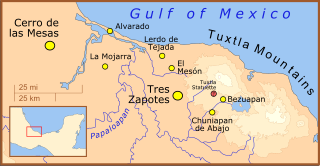
The Epi-Olmec culture was a cultural area in the central region of the present-day Mexican state of Veracruz. Concentrated in the Papaloapan River basin, a culture that existed during the Late Formative period, from roughly 300 BCE to roughly 250 CE. Epi-Olmec was a successor culture to the Olmec, hence the prefix "epi-" or "post-". Although Epi-Olmec did not attain the far-reaching achievements of that earlier culture, it did realize, with its sophisticated calendrics and writing system, a level of cultural complexity unknown to the Olmecs.

Yagul is an archaeological site and former city-state associated with the Zapotec civilization of pre-Columbian Mesoamerica, located in the Mexican state of Oaxaca. The site was declared one of the country's four Natural Monuments on 13 October 1998. The site is also known locally as Pueblo Viejo and was occupied at the time of the Spanish Conquest. After the Conquest the population was relocated to the nearby modern town of Tlacolula where their descendants still live.
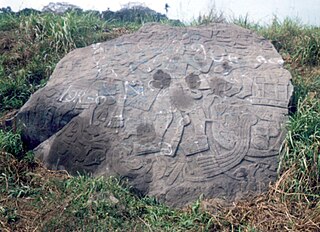
Bilbao is a Mesoamerican archaeological site about 1 mile (1.6 km) from the modern town of Santa Lucía Cotzumalguapa in the Escuintla department of Guatemala. The site lies among sugar plantations on the Pacific coastal plain and its principal phase of occupation is dated to the Classic Period. Bilbao was a major centre belonging to the Cotzumalhuapa culture with its main occupation dating to the Late Classic. Bilbao is the former name of the plantation on which the site lies and from which it has derived its name.
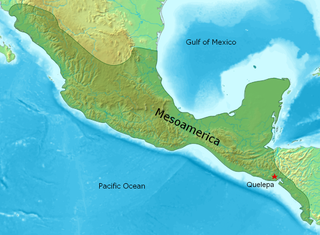
Quelepa is an important archaeological site located in eastern El Salvador. Generally considered to have been settled by the Lenca people, the site was founded around 400 BC in the Late Preclassic period. The inhabitants constructed a platform from plaster and pumice and rebuilt it a number of times. Artefacts recovered during the excavations of the site indicate that the local population depended upon subsistence agriculture, these artefacts included metates and comales. The site belonged to the Mesoamerican cultural region. Quelepa means "stone jaguar" in the Lenca language, probably in reference to the large Jaguar Altar found at the site.
Maya Ballgame, which is a branch of the Mesoamerican Ballgame, is a sporting event that was played throughout the Mesoamerican era by the Maya civilization, which was distributed throughout much of Central America. One of the common links of the Mayan culture of Mexico, Guatemala, Honduras, and Belize is the game played with a rubber ball, about which we have learned from several sources. The Maya ballgame was played with big stone courts. The ball court itself was a focal point of Maya cities and symbolized the city's wealth and power.

During the pre-Columbian era, human sacrifice in Maya culture was the ritual offering of nourishment to the gods and goddesses. Blood was viewed as a potent source of nourishment for the Maya deities, and the sacrifice of a living creature was a powerful blood offering. By extension, the sacrifice of human life was the ultimate offering of blood to the gods, and the most important Maya rituals culminated in human sacrifice. Generally, only high-status prisoners of war were sacrificed, and lower status captives were used for labor.

Chutixtiox is an archaeological site of the ancient Maya civilization near Sacapulas, in the Quiché department of modern Guatemala. The site was excavated during the 20th century by A. Ledyard Smith. Ceramic evidence excavated at the site suggests a close relationship with the K'iche' capital of Q'umarkaj. Chutixtiox may have been a settlement in a polity that included the nearby sites of Chutinamit and Xolpacol.

Guaytán is an archaeological site of the Maya civilization in the municipality of San Agustín Acasaguastlán, in the department of El Progreso, in Guatemala. It is the most important pre-Columbian archaeological site of the middle drainage of the Motagua River.

![]() -shape when viewed from above.
-shape when viewed from above.




